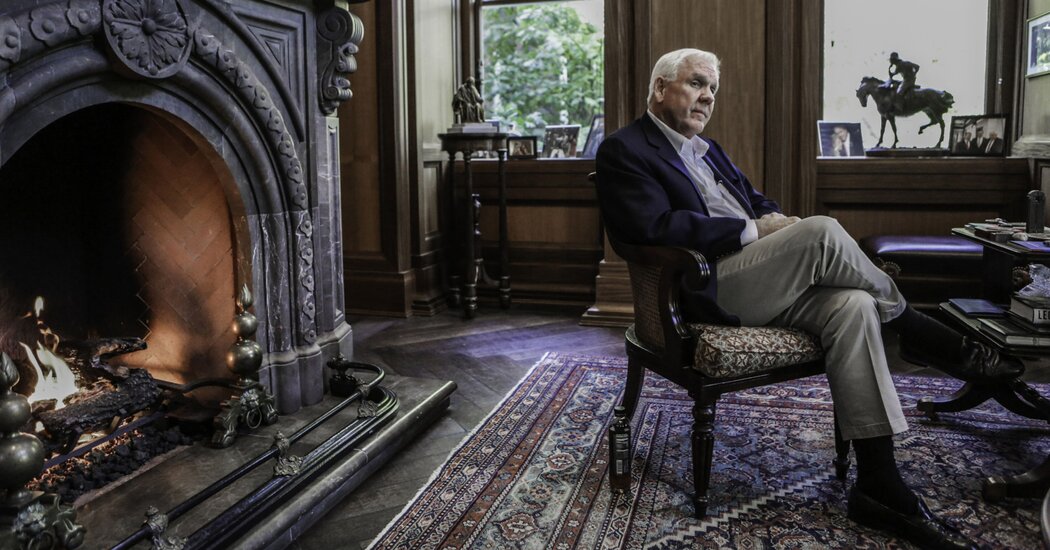WASHINGTON — Shortly after the leak of the draft opinion to overturn Roe v. Wade, Justice Clarence Thomas made headlines last spring when he told an audience in Dallas that the breach might have permanently damaged the court. Less noticed was what he said about his longtime friend, the conservative Texas real estate billionaire Harlan Crow.
As the justice settled into a chair by a fireplace at Old Parkland, a palatial office complex, his interviewer, John Yoo, a law professor at the University of California, Berkeley, thanked Mr. Crow, the owner of Old Parkland, for making “this wonderful facility available” for the talk.
“I know Harlan hates that,” Mr. Yoo said, a reference to the eccentric and press-averse Mr. Crow’s dislike of praise in public.
“That’s why I wouldn’t say it,” Justice Thomas chimed in, amused. “I’d like to keep that friendship.”
The precise nature of the friendship between the justice and Mr. Crow is under new scrutiny since ProPublica revealed last week that Justice Thomas did not disclose lavish gifts from Mr. Crow, including travel on the billionaire’s private jet, stays at his Adirondacks resort and island hopping in Indonesia on his superyacht.
Although Justice Thomas has said the two have been close friends for decades and the trips were personal, Mr. Crow — a longtime donor to conservative causes whose Dallas home includes paintings by Renoir and a signed copy of “Mein Kampf” — did not meet the justice until he was already on the court. The relationship has raised questions about whether such a friendship can be separated from politics and has intensified calls from Democrats for transparency and an ethics code for the justices.
“The fact that there’s no way to get an independent internal investigation of a justice is how Justice Thomas has been able to get away with all these reporting failures,” said Senator Sheldon Whitehouse, Democrat of Rhode Island. “There’s simply no process to look into any of this other than the justice making his own determination.”
Mr. Crow, 73, has since 2006 been a trustee of the Supreme Court Historical Society, a charity that asks for an annual contribution of $5,000 or more to further its mission of preserving the court’s history and educating the public. Mr. Crow is also a trustee of the George W. Bush Presidential Library Foundation and gave $500,000 to a group that ran advertisements to build public support for Mr. Bush’s Supreme Court picks.
Mr. Crow and his firm have not had a case before the Supreme Court during Justice Thomas’s time there, and in a statement to ProPublica said he and the justice and their wives kept the court and politics out of their friendship.
“We have never asked about a pending or lower-court case, and Justice Thomas has never discussed one, and we have never sought to influence Justice Thomas on any legal or political issue,” Mr. Crow said in the statement.
Understand the U.S. Supreme Court’s Term
But Mr. Crow has given the justice gifts over the years, including a Bible that once belonged to the abolitionist Frederick Douglass, valued at $19,000, and a bust of Abraham Lincoln worth $15,000.
Mr. Crow also commissioned a portrait of the justice and Mr. Crow, smoking cigars in Adirondack chairs alongside Leonard Leo, a conservative force in pushing courts to the right; Mark Paoletta, a former assistant White House counsel who was a key player in Justice Thomas’s confirmation; and Peter Rutledge, a lawyer and former clerk to the justice. The painting hangs in Mr. Crow’s private Adirondacks resort, Camp Topridge on Upper St. Regis Lake, the onetime summer home of Marjorie Merriweather Post. Mr. Crow has added to the grounds a replica of Hagrid’s hut, which appears throughout the “Harry Potter” books.
Mr. Crow did not respond to multiple interview requests, and Justice Thomas did not respond to a request for comment for this article. Robert Doar, the president of the American Enterprise Institute, who knows both men, said in a statement that “questioning Justice Thomas’s integrity based on his friendship with Harlan Crow is without merit.”
A Scion of Wealth
Mr. Crow first met Justice Thomas at a conservative policy forum, and the two became fast friends, according to “Supreme Discomfort: The Divided Soul of Clarence Thomas,” by Kevin Merida and Michael Fletcher. The book gives no date for the forum, but The New York Times has reported that Mr. Crow first met Justice Thomas in the mid-1990s, a few years after his October 1991 confirmation to the court.
The Dallas billionaire’s background could not have been more different from a justice born into poverty in coastal Georgia. Justice Thomas was abandoned by his father at the age of 7 and sent off to his grandparents in Savannah — the first time, he has said, that he lived in a home with a toilet.
Mr. Crow is a scion of great wealth. His father, Trammell Crow, was once the largest landlord in the United States and at one time had interests in nearly 300 million square feet of developed real estate in 8,000 properties in more than 100 cities. His projects ranged as far as Hong Kong and Brussels and in the United States included the Embarcadero Center in San Francisco and the Peachtree Center in Atlanta.
But the family business fell on hard times in a commercial real estate crash in the late 1980s, when Trammell Crow chose his third son, Harlan, to take over the company.
The younger Mr. Crow is credited with rebuilding the family’s wealth by anticipating the future of the industry in managing properties for others, not just developing and owning them. He managed to save his father’s favorite building complex, the Dallas Market Center. He put his siblings and parents on budgets. Eventually, he turned his father’s real estate partnerships into an even bigger empire.
In 2006, his company bought the site of Old Parkland, a former public hospital in Dallas, and turned it into the upscale office complex where Justice Thomas spoke last year.
More on the U.S. Supreme Court
- Uncomfortable Revelations: Democratic lawmakers reiterated calls to tighten ethics rules for the Supreme Court after ProPublica reported that Justice Clarence Thomas had accepted luxury gifts and travel from a major conservative donor without disclosing them.
- Trans Athletes: The Supreme Court issued a temporary order allowing a transgender girl to compete on the girls’ track team at a West Virginia middle school.
- A Constitutional Test: Two criminal defendants have asked the Supreme Court to decide whether testimony given remotely against them during the pandemic violated the Sixth Amendment’s confrontation clause.
Despite his high-profile business, Mr. Crow gives few interviews and rarely speaks in public.
“I wouldn’t care if John Q. Public had never heard of me,” he told The Times in 1996. “In fact, I’d prefer that John Q. Public hadn’t heard of me. It’s not a Howard Hughes privacy thing. It’s a what’s-the-point thing.”
Unlike his charismatic father, who ended conversations by saying “keep on smiling” with a wink and a thumbs-up, Mr. Crow is more reticent, with unusual tastes. Spread throughout a section of the garden of his home in the town of Highland Park, near Dallas, are what are known as his “dead dictator” statues, some as tall as 20 feet, of Lenin, Stalin and Mao. The collection also includes the Romanian dictator Nicolae Ceausescu and his wife Elena, as well as Gavrilo Princip, the Serbian assassin who helped set in motion World War I.
A 2003 interview with the man who acquired the statues for Mr. Crow cited failures to acquire statues of Pol Pot, the former leader of the Khmer Rouge, during a trip to Cambodia in 1997, and of Saddam Hussein on a trip to northern Iraq in 1991, as the Persian Gulf war was winding down.
Mr. Crow told Mariana Greene, a Dallas Morning News reporter who toured his home in 2014, that his collection was meant to preserve history, not to celebrate repressive regimes. “I’m a child of the Cold War,” he said. “You know who Tito is, but the next generation won’t. I don’t think Lenin will ever be forgotten, but I am trying to preserve that as a part of our history. American history and world history are very definitely related.”
His library includes paintings not only by Renoir but also by Monet, Winston Churchill and George W. Bush — and Adolf Hitler, who did most of his painting before World War I, after he was rejected from art school. Once in power, Hitler is thought to have destroyed some of his more embarrassingly bad paintings, but several hundred are known to exist. It is unclear how much of Hitler’s work is in Mr. Crow’s collection.
Ms. Greene, now retired from the Dallas paper, recalled that she was stunned when she saw a landscape by Hitler in a sitting room to the side of the library. “I just expressed shock that, one, that Hitler painted a pretty scene, and that Harlan Crow owned the painting,” she said in an interview. Mr. Crow, she added, “just really more or less nodded in agreement. He spoke more about Churchill and George Bush’s work.”
Karl Rove, George W. Bush’s longtime adviser who has a gift from Mr. Crow of a chair from the McKinley administration in his office, said he had no idea where the billionaire found the artwork by Hitler. “He points it out as the madness of the man,” Mr. Rove said in an interview.
Another Dallas Morning News article, in 2008, reported that Mr. Crow had Hitler’s place settings and linens, “kept in a closed cabinet, so the swastikas are not on display.”
That same article, by Michael Merschel, noted a handwritten letter of thanks from Justice Thomas that was displayed next to a Senate roll call card showing his confirmation to the Supreme Court.
In 2021, The Wall Street Journal featured Mr. Crow’s efforts to build a 228-foot bell tower outside his office window at Old Parkland in the middle of Dallas. Mr. Crow told The Journal that the bell tower was a gift to the city to celebrate entrepreneurial ambition. He had spent $25 million on the project, which included a 30,000-pound brass bell that Mr. Crow named Horatio, after Hamlet’s friend.
His longtime architect and friend, Rick Keating, told The Journal that Mr. Crow’s motivation was easy to understand.
“He’s a unique person with a lot of money,” Mr. Keating said. “The real story is Harlan does what he wants to do.”
Kitty Bennett contributed research.
















Leave a Reply